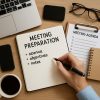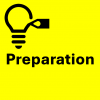Tip
When creating an agenda, think of each item as a step in a narrative that will culminate in achieving the intent of the meeting. If you can’t describe how one step leads to the next, your attendees might get lost.
Details
Writing a meeting agenda is a lot like writing a book. Both need a clear structure that guides people from beginning to end. Just as a book starts with an introduction to set the stage, a meeting agenda should open with context—why everyone is gathered and what the session is about. This gives participants orientation and purpose, much like a reader finding their footing in a new story.
The middle of the agenda, like the chapters of a book, is where the journey unfolds. Each agenda item represents a step along the path, building momentum and leading naturally toward the outcome. Sequencing matters: just as a book has a logical flow of events, a meeting agenda should move from foundational discussions to deeper decisions.
Finally, every book has a conclusion that ties everything together. In a meeting, that conclusion is the intent—the decision made, the problem solved, or the next step agreed upon. When you design your agenda with this storytelling mindset, you create a meeting that feels purposeful, coherent, and engaging from start to finish.

